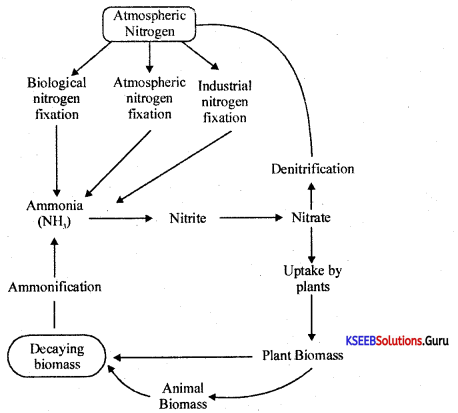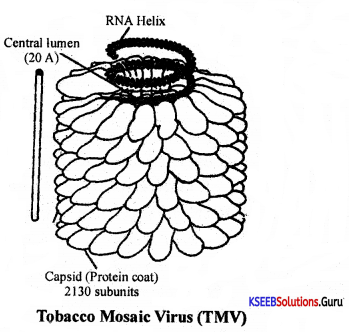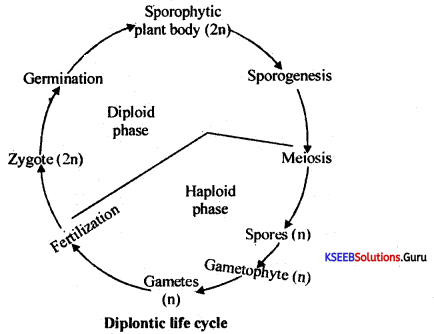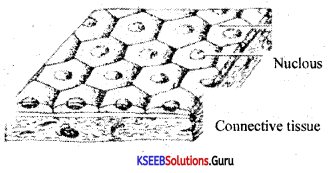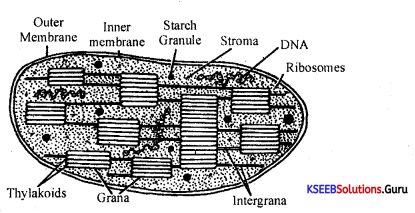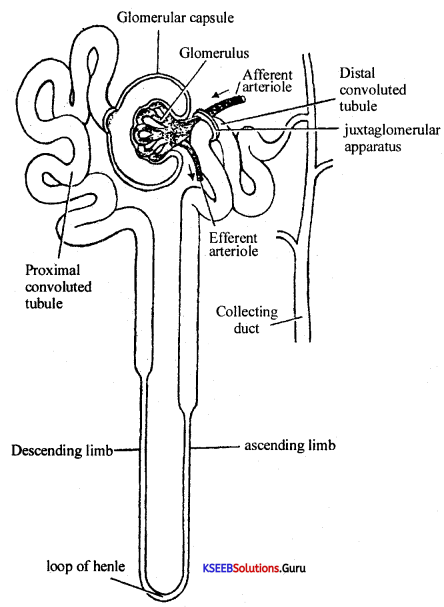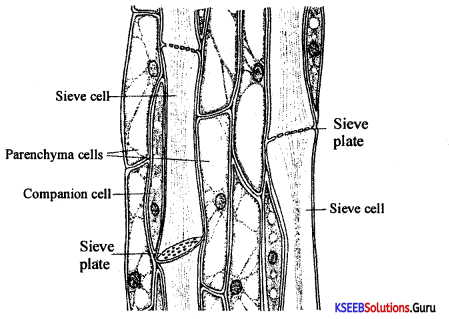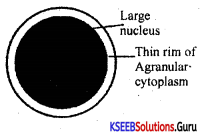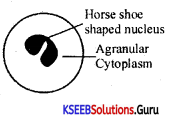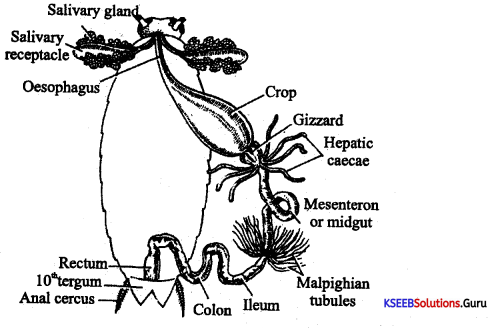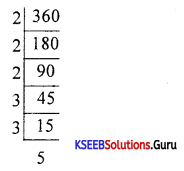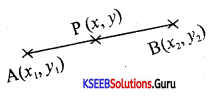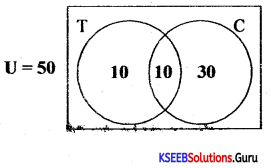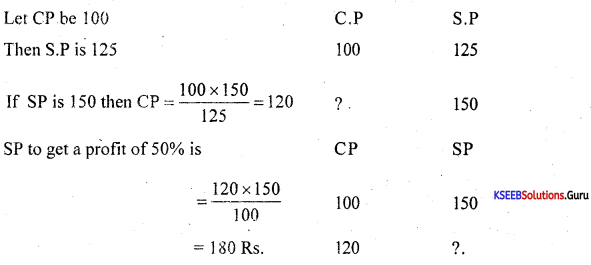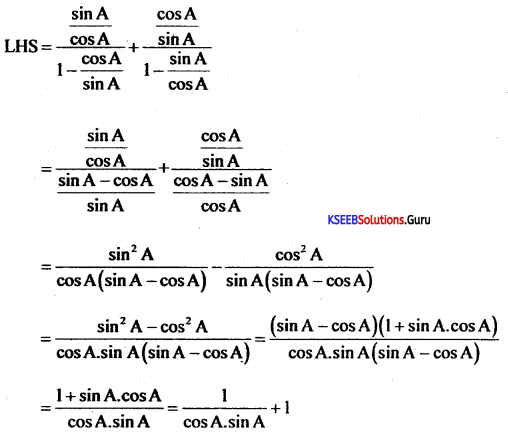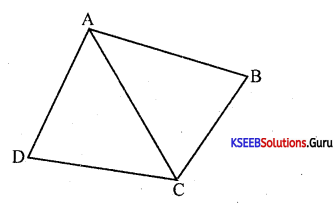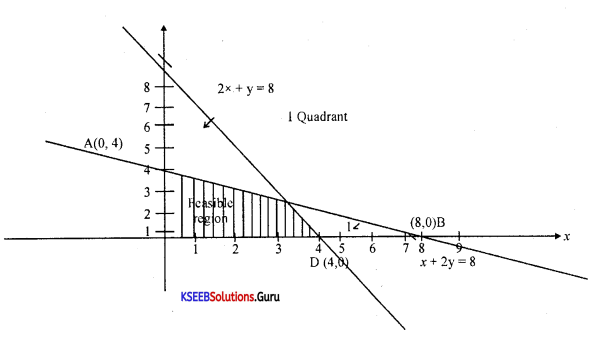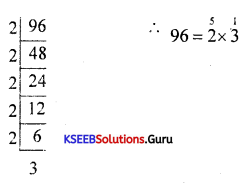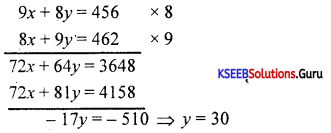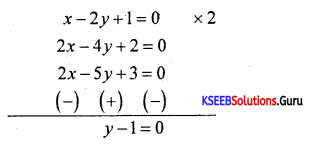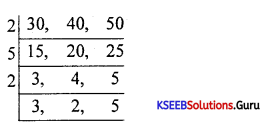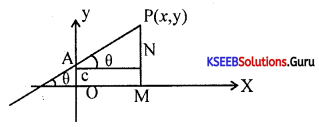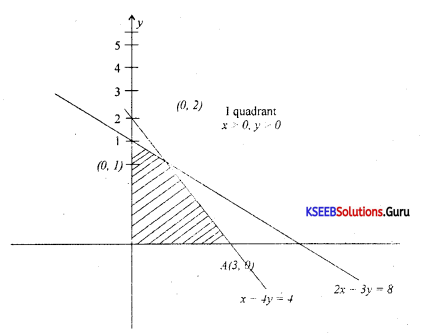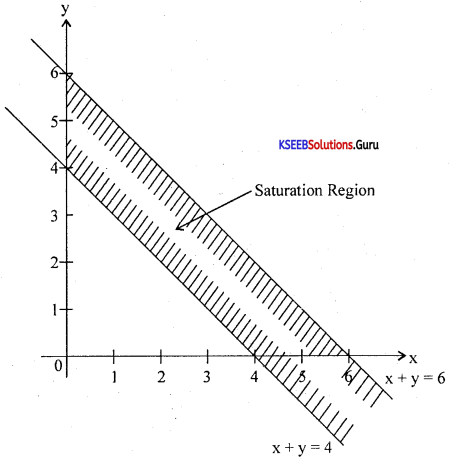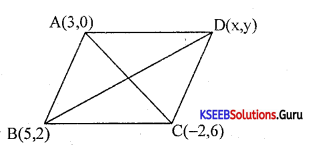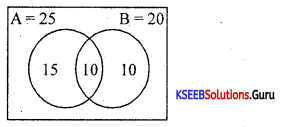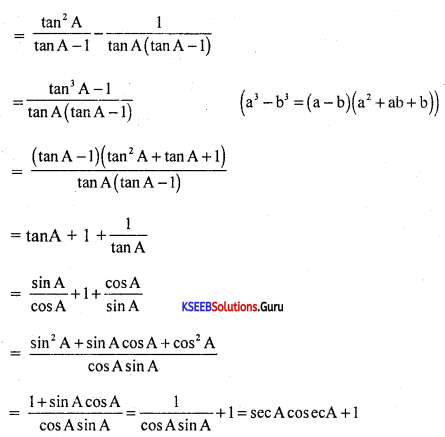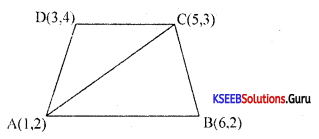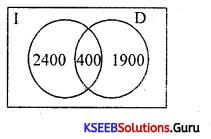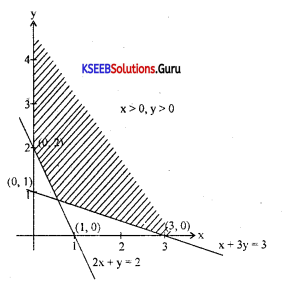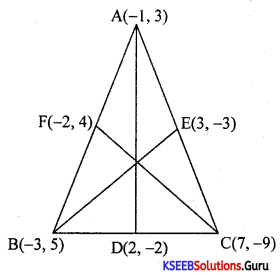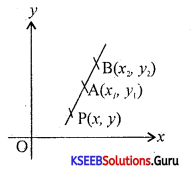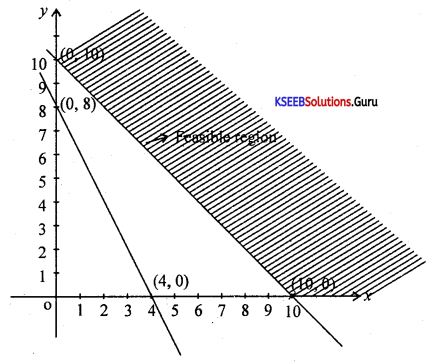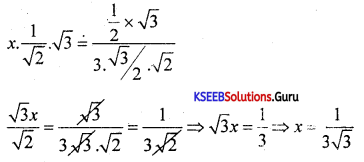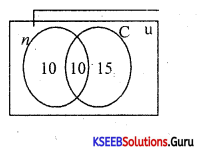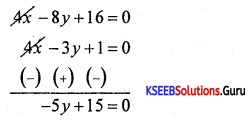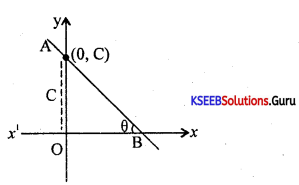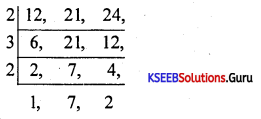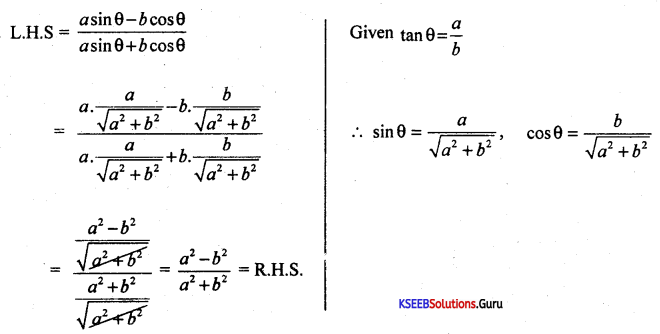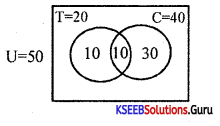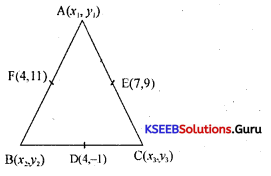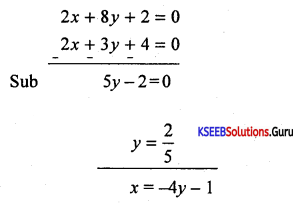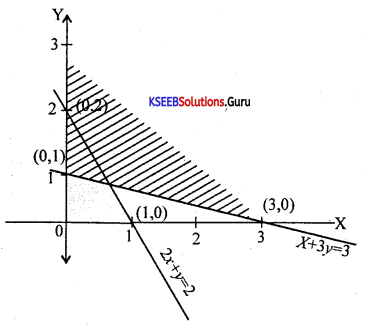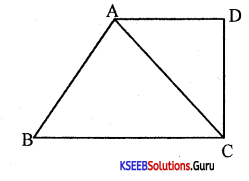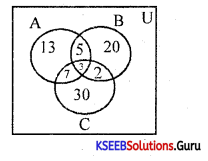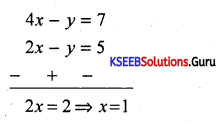Students can Download 1st PUC Biology Model Question Paper 6 with Answers, Karnataka 1st PUC Biology Model Question Papers with Answers helps you to revise the complete Karnataka State Board Syllabus and score more marks in your examinations.
Karnataka 1st PUC Biology Model Question Paper 6 with Answers
Time: 3.15 Hours
Max Marks: 70
General Instructions:
- The question paper consists of four parts A, B, C and D.
- All the parts are compulsory.
- Draw diagrams wherever necessary. Unlabelled diagrams or illustration do not attract any marks.
Part – A
Answer the following questions in one word / one sentence each: ( 10 × 1 = 10 )
Question 1.
What is a Monograph?
Answer:
Monographs give a comprehensive account of a complete compilation of available information of anyone’s family or genus at a time.
Question 2.
What are viroids?
Answer:
These are the small infectious self-replicating RNA particles lacking protein coats.
Question 3.
Define Species?
Answer:
It is a group of individuals with similar morphological characters and who can freely interbreed among themselves, to produce fertile offsprings of their own kind.
Question 4.
What is phyllotaxy?
Answer:
The mode of arrangement of leaves on the stem axis is known as phyllotaxy.
![]()
Question 5.
Name the Chemical matrix of bone?
Answer:
Ossein.
Question 6.
Name the main component of the secondary cell wall?
Answer:
Lignin or pectin.
Question 7.
Define Imbibition?
Answer:
Imbibition is a special kind of diffusion that involves the movement of water molecules along a diffusion gradient from a region of higher concentration onto a suitable solid matrix (adsorption).
Question 8.
Name the hormone responsible for fruit ripening?
Answer:
Ethylene.
Question 9.
What is Gout?
Answer:
It is a disorder caused due to the accumulation of uric acid crystals in joints.
Question 10.
Name the hyperglycemic hormone?
Answer:
Glucagon.
PART-B
Answer any FIVE of the following questions in 3-5 sentences each. (5 × 2 = 10)
Question 11.
List any two uses of Bacteria?
Answer:
As natural Scavengers: They decompose dead parts of animals, plants, and other organic matters into simpler inorganic matters. e.g.: Proteus, Clostridium, Bacillus, etc.
As fermenting agents:
eg: Vinegar (acetic acid) is obtained from alcohol by fermentation in the presence of the bacterium Acetobacter acetic.
![]()
Question 12.
Draw a neatly labeled diagram of Chloroplast?
Answer:
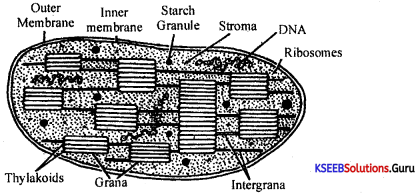
Electron microscopic structure of the chloroplast
Question 13.
Write the Linnaenean Hierarchy of Mango?
Answer:
| Kingdom | Plantae |
| Phylum | Tracheophyta |
| Class | Dicotyledonae |
| Order | Sapindales |
| Family | Anacardiaceae |
| Genus | Mangifera |
| Species | Indica |
Question 14.
Write any four characters of meristematic Tissues?
Answer:
- Cells of the meristem may be spherical, oval, polygonal, or rectangular in shape.
- The cell wall is thin and made up of cellulose only.
- Intercellular spaces are absent because of compact arrangements.
- Each cell has a large nucleus and a dense cytoplasm usually without vacuoles.
- Cells are highly active and exhibit rapid divisions.
- Plastids are in proplastid state.
- Mitochondria and endoplasmic reticulum are less complex in organization.
- Cells do not store food materials.
- The cells lack orgastic substances.
Question 15.
What are the functions of the Liver?
Answer:
- It is a storehouse for glycogen and some vitamins.
- It secretes bile juice, which helps in the emulsification of fats.
- It is responsible for the detoxification of the digested food.
- It provides proteins like fibrinogen and prothrombin, that are involved in the clotting of blood.
![]()
Question 16.
Distinguish between Vital capacity and Total lung capacity?
Answer:
Vital Capacity (VC): It is the total volume of air that can be expelled from the lungs during maximum exhalation.
VC = TV + IRV + ERV
= 500 + 2500+ 1100
= 4100 ml approx.
Total lung capacity (TLC): It is the maximum volume of air that can enter the lungs during forceful inspiration,
TLC = VC + RV
= 4100 + 1600
= 5200 approx.
Question 17.
Which hormonal deficiency is responsible for the following?
(a) Diabetes mellitus
(b) Goitre
Answer:
(a) Insulin
(b) Thyroxine.
Question 18.
Write the excretory organs of (a) Arthropoda (b) Mollusca.
Answer:
(a) Malpighian tubules
(b) Metanephridia.
PART-C
Answer any FIVE of the following questions in 40-80 words each: (5 × 3 = 15)
Question 19.
List the General characters of Gymnosperms.
Answer:
General features:
1. The life cycle has a distinct, dominant, diploid, asexual phase represented by the well-differentiated evergreen woody plant, which is known as the sporophyte.
2. The sporophyte is heterosporot4s bearing .microspores and megaspores within microsporangia and megasporangia respectively. These structures occur on leaf-like microsporophylls and megasporophylls. These are further organized into fertile structures called Strobili or cones.
3. Sporophyte shows the presence of a taproot system which is well developed. The stem possesses branches that are dichotomies. Leaves are well developed and are dimorphic (two types of leaves): viz,
- Green photosynthetic leaves (Foliage).
- Brown-colored scale leaves.
4. Microspore develops into male gametophyte arid megaspore produces female gametophyte.
These gametophytes represent the haploid phase and are highly inconspicuous in comparison with sporophytic generation.
5. Female gametophyte is enclosed within a megasporangium that in turn is covered by an integument. Such a tegument megasporangium possessing the female gametophyte is called an ovule.
6. Endosperm or female gametophyte is regarded as per the fertilized product and is haploid.
7. Semigerminated pollen grains (microspores) are liberated from the microsporangium and are pollinated onto the ovule. In the ovule, they sit in the pollen chamber and complete germination by producing a pollen tube which enters into nucellus, female gametophyte endosperm and ultimately enters archegonia and reaches the egg located in the center region. The tip of the pollen tube bursts releasing sperm cells which fuse with the egg to form a zygote. (Simultaneously 2-3 archegonia in an ovule fertilized).
8. Embryogeny takes place where only one functional embryo is formed along with seed development.
9. The seed germinates to form a new sporophyte.
Question 20.
List the functions of the endoplasmic reticulum.
Answer:
(Serves as secretary, storage, circulatory and nervous system for the cell).
1. ER forms the ultrastructural skeletal framework (cytoskeleton) to the coli and gives mechanical support to the colloidal cytoplasmic matrix.
2. It takes part in the transportation of substances. It is an efficient intracellular transportation channel that connects nuclear membrane and cell membrane and permits the exchange of molecules through its membranes by the process of osmosis, diffusion, and active transport.
3. It provides an increased surface area of various enzymatic reactions like protein synthesis. Also, ¡t contains many enzymes, and thus takes part in synthetic and metabolic activities.
4. It is useful in intracellular impulse conduction, and thus nucleus is able to respond quickly to change in the cell’s immediate environment.
5. It forms the new nuclear envelop, after each nuclear division.
6. It contributes to the formation of the cell plates. during telophase of cell division in plants.
7. Smooth endoplasmic reticulum takes part in lipid synthesis. break down of glycogen and detoxification of drugs.
8. Rough endoplasmic reticulum takes part in protein synthesis and secretion of enzymes.
![]()
Question 21.
Mention the role of Gibberellins in plants.
Answer:
- Discovered by Kurasawa in paddy seedlings, while investigating the cause for Bakane disease.
- Yabuta, and Suzuki isolated gibberellins from the fungi GibberellafuzikorL
- Gibberellins break genetic dwarfism ¡n dwarf varieties of pea and beans.
- Can induce internode elongation and early flowering in rosette plants like cabbage and cauliflower. This is called bolting.
- Can break seed dormancy and bud dormancy.
- Can induce parthenocarpic fruits.
- Gibberellins can substitute cold treatment i.e., can replace ‘vernalization.
- Can be used in inducing flowers even in off-seasons in long-day plants.
Question 22.
Define the following (a) Epigynous flower (b) phyllotaxy (c) venation.
Answer:
(a) a flower possessing inferior ovary
(b) The mode of arrangement of leaves on the stem axis is known as phyllotaxy.
(c) The mode of arrangement of veins and veinlets is called venation.
Question 23.
Explain the transport of carbon dioxide by blood.
Answer:
CO2 is produced within the body cell as a metabolic waste product of oxidative metabolism.
CO2 is transported from cells to the alveoli through the following forms.
- In the form of carbonic acid (7%).
- In the form of carbamino hemoglobin (23%).
- In the form of bicarbonates of Sodium and Potassium (70%).
Question 24.
Briefly explain the digestion of carbohydrates in the small intestine.
Answer:
a. Digestion in the mouth: The salivary amylase or ptyalin converts starch and glycogen into maltose units.
![]()
b. Digestion in the intestine :
Pancreatic juice: Carbohydrase secreted by the pancreas is called pancreatic amylase. It converts starch and glycogen into maltose units.
![]()
Intestinal juice: It consists of three types of carbohydrates.
Maltase: Maltase catalyzes the hydrolysis of maltose (disaccharide) into glucose units (monosaccharides).
![]()
Sucrase: Sucrase catalyzes the splitting of sucrose (disaccharide) into glucose, and fructose units (monosaccharides).
![]()
Lactase: Lactase acts on milk sugar lactose (disaccharide), and splits lactose into galactose, and glucose units (monosaccharides).
![]()
Question 25.
Briefly explain any two disorders of the respiratory system.
Answer:
Asthma (Bronchial asthma):
It is a common disorder of the lower parts of the respiratory system involving smaller bronchi and bronchioles. It is caused due to an allergic reaction to foreign substances in the respiratory system. The substances which are responsible for asthma are called allergic substances or allergic agents.
In allergic asthma, the individuals become allergic to certain allergens like platinum salts, sulfur dioxide, and aeroallergic agents like pollen grains, dust, and animal dandruff. Asthma is also caused due to bacterial infection to bronchi, and bronchioles.
Symptoms [Effect]:
- Difficulty in breathing and suffocation.
- Continuous coughing and wheezing.
- Tightness in the chest (Lungs).
- The swelling of bronchial walls takes place and secretes large quantities of thick mucus Allergic asthma can be prevented by avoiding exposure to the particular allergic agent, which causes it.
![]()
Question 26.
What is binomial nomenclature? Write any two rules of binomial nomenclature.
Answer:
This method was introduced by Carolus Linnaeus.
In this method, every organism is given a scientific name, which has two parts, the first is the name of the genus (generic name), and the second ¡s the name of the species (specific epithet).
e.g. Mangifera indica for mangoes and Homo sapiens for human beings. In the above, Mangifera and Homo are generic names, while India and sapiens are the names of the species belonging to Man gear and Homo respectively.
The classification consists of a hierarchy of steps where each step represents a range or category. The various ranges or categories used in classification are called Taxonomic categories.
PART-D (Section I)
Answer any FOUR of the following questions in 200-250 words each wherever applicable: (4 × 5 = 20)
Question 27.
Explain the different steps in Mitosis?
Answer:
Mitotic division: Mitotic division has two processes occurring simultaneously.
They are:
(A) Karyokinesis and
(B) Cytokinesis.
A. Karyoldnesis: (Gr: Karyon-nucleus; kinesis-movement): It is a continuous process and for convenience divided into four stages. They are prophase, metaphase, anaphase, and telophase.
I. Prophase: (Gr: pro-first, phases-stage): It follows the interphaše and is characterized by the following features :
The already duplicated chromosomes become progressively shorter and thicker due to condensation. The spindle fibers appear between the centrioles present at the poles.
- The nucleolus diminishes in size and finally disappears.
- The nuclear envelope ¡s partly disintegrated.
II. Metaphase: (Gr. Meta-after or second: phases-Stage) It is characterized by the following features.
- Spindle fibres are completely formed.
- The spindle fibres that are attached to chromosomes arç called chromosomal fibres.
- The chromosomes aggregate in the center of the cell. They come to lie in the equatorial places to form an equatorial plate.

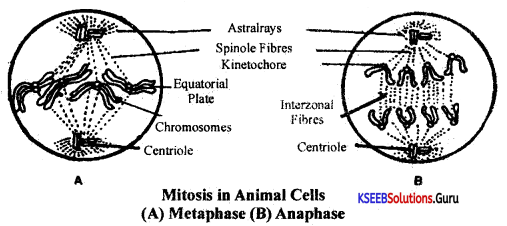
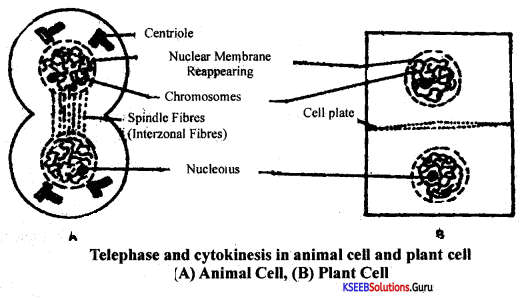
III. Anaphase (Gr:ana-up; phases-stage):
Anaphase ¡s is characterized by the following features.
The two chromatids of each chromosome separate complétely, to become daughter chromosomes. The two daughter chromosomes move away from the equator towards the opposite poles.
During the anaphasic movement of chromosomes, the centromeres lead the path, and the arms trail behind. As a result, the anaphasic chromosomes app&r V, L, J, and I shaped.
IV. Telophase (Gr:telos-end; phases-stage):
It is characterized by the following features. ,.
- Here, reversal of the prophasic events occur. The daughter chromosomes move and reach the opposite poles where they become thin and thread-like again. These threads overlap one another to form a fine chromatin network.
- The spindle fibers disintegrate and disappear.
- Reconstitution of a new nuclear envelope occurs. Nucleolus reappear.
B. Cytokinesis: (Gr:kytes-hollow; kinesis-movement): The division of the cytoplasm is called cytokinesis. A furrow develops in the middle of the cell. They deepened centripetally, till the cytoplasm is divided into two equal parts. It forms two daughter cells.
![]()
Question 28.
Draw a neatly labeled diagram of L.S. of phloem and explain briefly.
Answer:

Phloem is a food conducting tissue and is also called bast. Phloem is composed of four elements:
(a) Sieve elements
(b) Companion cells
(c) Phloem parenchyma
(d) Phloem fibers.
(a) Sieve elements: Sieve elements in lower vascular plants (Pteridophytes and gymnosperms) are referred to as ‘sieve cells’ whereas in higher plants (Angiosperms) they are referred to as ‘sieve tubes’.
Sieve cells are elongated, thin-walled, and arranged one above the other, and show a thin protoplasmic layer within. Sieve cells possess perforated lateral walls and they are not associated with companion cells, but with the cells called albuminous cells.
Sieve tubes are much longer than sieve cells and are arranged one above the other longitudinally with perforated transverse end walls, called ‘sieve plates’. Protoplasmic strands maintain the continuity through these perforations with the adjoining sieve tubes, sieve tubes are living cells but they are enucleated.
At the end of the growing season, sieve pores are covered by deposits of callose.
(b) Companion cells: These are thin-walled living and narrow cells running parallel to sieve tubes in angiosperms. Sieve tubes and companion cells are sister cells derived from the same mother cell. These are known to regulate the functions of sieve tubes.
(c) Phloem parenchyma: Parenchyma cells associated with phloem are referred to as phloem parenchyma. They are stored in function. Phloem parenchyma is absent ¡n monocot stem.
(d) Phloem fibers: These are sclerenchyma fibers associated with them. They are also called hast fibers. They provide mechanical support to the plant body.
Question 29.
Explain the structure of Neuron with a neatly labeled diagram?
Answer:
Structure of Neurons:
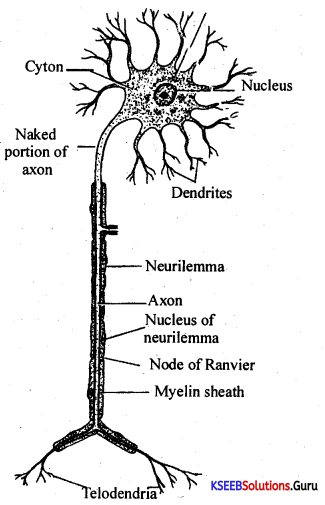
- Each neuron has a cell body, dendrons (dendrites), and an axon.
- The cell body contains cytoplasm with a nucleus, and certain granular bodies, called Nissil granules.
- A number of processes (outgrowths) arise from the cell body. The longest among them is called axons while the others are called dendrons and their branches dendrites.
- The axon is a long fiber and is branched at its distal end. Each branch terminates as a bulb-like structure called synaptic knob, which contains synaptic vesicles with neurotransmitters.
- The axon transmits the impulses away from the cell body, while the dendrites! dendrons conduct it to the cell body.
- Axons are of two types depending on the presence or absence of a myelin sheath around them. They are called myelinated axons/nerve fibers and non-myelinated axons.
- The myeÌinated nerve fibers are enveloped with Schwann cells, which form a myelin sheath around the axon.
- The myelin sheath is not continuous and the gaps are called nodes of Ranvier.
- Myelinated nerve fibers are found in the brain and spinal cord, while nonmyelinated fibers are commonly found in autonomous and somatic neural systems.
Question 30.
Explain the factors affecting photosynthesis.
Answer:
The following factors influence photosynthesis:
1. Light: Sunlight is used as a primary source of energy. Its three aspects affecting the process are:
(a) Light Intensity: Optimum light intensity for photosynthesis is 2000-2500 foot candles/ Higher light intensity bleaches chlorophyll and is called solarisation.
(b) Light Quality: Photosynthetic rate ¡s maximum in red light, next maximum in blue light, and least in green light.
(c) Duration: Photósynthetic rate is more efficient in intermittent light than in continuous light supply.
2. CO2: Used as a raw material in photosynthesis. Its concentration in air is 0.03%. Its increase up to 0.5% increases the rate of the process but above 0.5% inhibits photosynthesis.
3. O2: Liberated as a by-product in photosynthesis. its increase above the normal 21% in air, decreases the rate of the process. It is called the Warburg effect.
4. Temperature: It affects photosynthesis through its influence on the enzyme-controlled dark reaction. The optimum temperature is 18 – 40°C for photosynthesis.
5. Water: Used as a raw material in photosynthesis. In the dehydrated state of cells, photosynthesis is inhibited.
![]()
Question 31.
(a) What is photoperiodism? Classify plants based on photoperiodism.
Answer:
Plants, in order to flower, require a particular day length or light period called photoperiod, and the response of the plants to photoperiod in terms of flowering is called photoperiodism.
Photoperiodism was first studied by W.W. Garner, and HA. Allard.
Based on their photoperiodic responses, plants are classified into the following groups:
- Long Day Plants: These flower in photoperiod more than critical day length. eg: Wheat, oats, etc.
- Short Day Plants: These flower in photoperiod less than critical day length. e.g: Tobacco, Chrysanthemums, etc.
- Day Neutral Plants: These are the plants that are not influenced by the duration of light for their flowering.
e.g: Tomato, cucumb&, cotton, etc.
(b) List the uses of Transpiration?
Answer:
The important external factors that influence the rate of transpiration are:
1. Light: Light directly increases the rate of transpiration by inducing the opening of stomata.
Starch is formed in the guard cells in the presence of light. Starch gets converted into sugars which absorb water into the guard cells. Guard cells become turgid, and stoma opens, and the rate of transpiration increases. When there is no light the stomata gets closed, and the rate of transpiration decreases.
2. Temperature: When temperature increases, the atmospheric humidity decreases, and the rate of transpiration increases, and when temperature decreases, transpiration decreases.
3. Atmospheric humidity: It is the amount of water vapor present in the atmospheric air. When the atmospheric humidity is more, the rate of transpiration is less, and when atmospheric humidity is less the rate of transpiration is more.
4. Wind velocity: Plants produce a cloud of water vapor just above the leaves which reduces the rate of transpiration. When wind velocity removes the water vapor around the plant, then the rate of transpiration increases. But a very high wind velocity tends to close the stomata, and the rate of transpiration decreases.
5. AvaiLability of soil water: When there is less soil water, the rate of water absorption Asics, and rate of transpiration is also less.
Question 31.
Explain Transpiration -pull theory of Ascent of Sap?
Answer:
It is one of the most successful physical theories of the ascent of sap. Dixon and Jolly proposed this theory. According to this theory, the ascent of sap is due to three factors namely,
(a) Cohesive force of water
(b) Adhesion of water molecules to the walls of the xylem vessel
(c) Transpiration pull
A strong intermolecular force of attraction exists between water molecules. Thus water molecules are bound to each other forming a continuous column of water.
There is a force of attraction between water molecules on the inner walls of xylem elements.
Therefore water molecules are attached to the wall of the xylem. It is called adhesion.
Due to the adhesive and cohesive properties of water, a continuous column of water is presold in the xylem.
Transpiration at the leaf surface forces the mesophyll cells of the leaves to draw water from the neighboring xylem elements. This creates a suction force known as Transpiration pull.
This suction force pulls the water column in the xylem upwards. This ascent of sap is due to the combined effect of adhesive, and cohesive properties of water and transpiration pull.
Question 32.
List the salient features of Phylum Annelida.
Answer:
Annelida and the remaining phyla under kingdom Animaba possess a true body cavity, hence are included under the grade Eucoelomata.
A principal feature of this phylum is the division of the body into similar parts or segments or metameres, marked externally by transverse grooves and internally by septa. Each segment or metamere posts the representatives of all the organs of the body namely blood vessels, ‘muscles, nerves, excretory and reproductive organs. This phenomenon is known as segmentation or metamerism.
Annelids show cephalization union of a few of the anterior body segments to form ahead which is specialized by the development of nervous, sensory, and feeding structures.
Section II
Answer any THREE of the following questions in 200-250 words each. (3 × 5 = 15)
Question 33.
Draw a neat labeled diagram of the female reproductive system of cockroaches.
Answer:
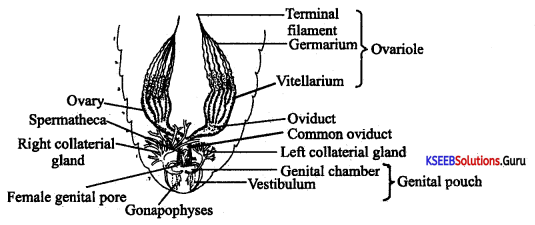
Question 34.
Write the sequential steps of Glycolysis.
Answer:
- It occurs ¡n the cytoplasm of the cell.
- It is an enzymatic reaction, thus temperature sensitive.
- It is a common reaction for both aerobic and anaerobic respiration.
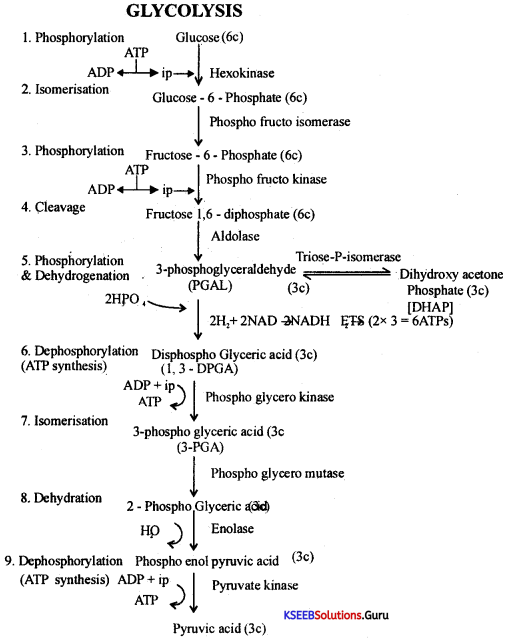
![]()
Question 35.
Explain the structure of Mitochondria with a neatly labeled diagram.
Answer:
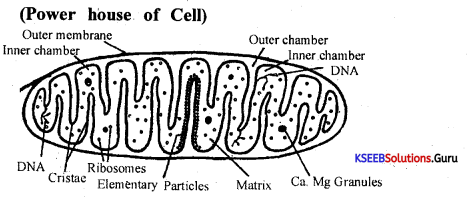
Section through mitochondrion (diagrammatic)
The elementary particles have been shown only on one crista.
It is present in eukaryotes except for mammalian RBC, and absent in prokaryotes. Its shape is oval, or sausage. Its number per cell depends on the metabolic state of the cell.
Structure: The mitochondria are bounded by two lipoprotein unit membranes namely the outer membrane and inner membrane. In between, their lies per mitochondrial matrix containing water, minerals, and enzymes.
The outer membrane is smooth and unfolded while the inner membrane ¡s folded and it produces an inward finger-like process called Cristae. Along the inner surface of the inner membrane, there is numerous tiny tadpole-like structures called elementary particles or F1 particles, Racker’s particles, or exosomes. F1 particle contains basal piece. stalk and head.
Sites of ATPase are between adjacent elementary particles. The inner membrane contains an electron transport system. it is made up of a chain of co-enzymes in the order of NAD, FAD, cytochrome B, cyt C, cyt A, cyt A3. The inner space of mitochondria is filled with a dense fluid called mitochondria matrix containing water, proteins, lipids, all enzymes of Kreb’s cycle, circular DNA, and 80s ribosomes.
Functions:
- Mitochondria are the centers of aerobic respiration.
- They are the sites of synthesis and storage of energy as ATP. Hence called the powerhouse of the cell.
- As they have circular DNA & ribosomes, they synthesize a few proteins for their own requirement. Hence they are called ‘Semi-autonomous cell organelles’.
Question 36.
Mention any five hormones of the pituitary with one function of each.
Answer:
The pituitary gland weighs about 0.5 gm and is a pea-sized endocrine gland that lies on the ventral surface of the brain attached to the hypothalamus by a nervous stalk called the infundibulum.
It is called the master gland or conductor of the endocrine orchestra as several of its hormones control other endocrine glands directly. The hormones of the pituitary that influence other endocrine glands are called tropins or trophic hormones. However, the pituitary gland itself works under the influence of the hypothalamus through releasing factors. The pituitary gland is called the master gland because it controls the functions of other endocrine glands by secreting hormones.
Based on origin, it is divided into two parts namely Adenohypophysis and Neurohypophysis.
1. Adenohypophysis (Anterior Pituitary) :
It accounts for nearly 75% of the total weight of the gland. It is derived from the buccal cavity in the form of a projection called Rathke’s pouch.
Adenohypophysis is further divided into three regions: Pars distalis, Pars intermedia, and Pars tubular. Pars intermedia degenerates during fetal development and occurs only as a small strip in adults. Pars tubular has no functional significance. Adenohypophysis cells secrete seven major hormones.
1. Somatotrophic hormone or Human growth hormone (STH or HGH): Promotes the growth of muscles. It stimulates the uptake of amino acids by tissues and their synthesis into proteins.
- Hypo secretion in childhood causes Pituitary dwarfism. Such an individual will be abnormally dwarf and is called a midget.
- Hypersecretion in childhood causes Pituitary gigantism. Such an individual will be abnormally tall.
- Hypersecretion in adolescence causes acromegaly which is characterized by the formation of disproportionately large hands, feet, cheekbones, jaws, etc.,
2. Thyroid-stimulating Honnone (TSH): Controls secretion of thyroid hormones by the thyroid gland and also regulates iodine intake by the thyroid gland.
- Hypo secretion leads to goiter, cretinism, and myxoedema.
- Hypo secretion leads to hyperthyroidism.
3. Adrenocorticotrophic hormone (ACTH): It controls the( secretion of hormones (Cortisone) by the adrenal cortex.
- Hypersecretion of ACTH causes Cushing’s syndrome.
- Hypo secretion causes Addison’s disease.
4. Follicle Stimulating Hormone (FSH): In females the induces growth and maturation of Graffian follicle and stimulates follicular secretion of estrogen. In males, it stimulates the testis to produce sperm.
5. Luteinizing Hormone or Interstitial Cell Stimulating Hormone (EH or ICSH): In females, it stimulates ovulation and the formation of the corpus luteum. In males, it stimulates interstitial cells in the testis to secrete testosterone.
6. Prolactin or Lactogenic or Luteotropic Hormone (LTH): In females, it causes growth and development of breasts during pregnancy. It stimulates milk production and secretion after childbirth, it inhibits ovulation during pregnancy and breastfeeding.
7. Melanocyte Stimulating Hormone (MSH): Increases skin pigmentation by stimulating dispersion of melanin in amphibians but its exact role in humans is unknown.
![]()
Question 37.
List the salient features of the phylum Arthropoda.
Answer:
The phylum Arthropoda is the• largest phylum of the animal kingdom. It includes more than 80% of all the known animals. They are found in marine, terrestrial and aerial habitats.
They are the only major invertebrates adapted to live on dry land.
Insects among arthropods are the only invertebrates capable of flight. More than about 10,00,000 species of arthropods have been described so far.
1. Arthropods are bilaterally symmetrical, triploblastic, metamerically segmented, and coelomates.
2. Segmentation of the body is less apparent and the number of segments is fewer in number.
3. They show the highest degree of cephalization, that is the formation of a well-developed head. The Head is usually formed by the fusion of six body segments. Following the head, the region is the trunk which is usually divisible into an anterior thorax and a posterior abdomen.
4.Their body segment usually bears paired lateral and jointed appendages. A segment of the appendage is known as podomere. The appendages are variously modified in different groups and even in different parts of the same animal.
- A few appendages close to the mouth are modified into jaws and are helpful in feeding.
- A few appendages are sensory in function.
5. Some appendages help, in locomotion. Due to the presence of jointed appendages or legs for locomotion, the phylum gets the name Arthropoda, which means jointed feet.
6. The exoskeleton ¡s periodically cast off and regrown at regular interv1s. This is redundant. This periodic casting off of the exoskeleton is known as ecdysis or mouthing. The presence of a chitinous exoskeleton does not permit the free growth of the animal. to overcome this problem, the exoskeleton is periodically cast off.
The stages between the series of molts are called instars. The animal grows during intervals between successive molts.
7. Muscles are present, which are segmentally arranged in bundles.
8. The body cavity is filled with blood and such a cavity or coelom is known as a hemocoel. The hemocoel doesn’t bear the lining of the coelomic epithelium. The true coelom is reduced and is confused to the spaces of excretory and genital organs.


